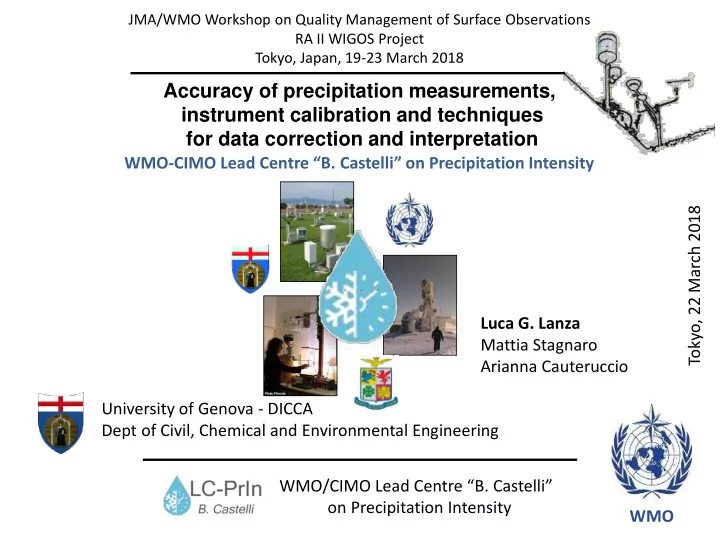

JMA/WMO Workshop on Quality Management of Surface Observations RA II WIGOS Project Tokyo, Japan, 19-23 March 2018 Accuracy of precipitation measurements, instrument calibration and techniques for data correction and interpretation WMO- CIMO Lead Centre “B. Castelli ” on Precipitation Intensity Tokyo, 22 March 2018 Luca G. Lanza Mattia Stagnaro Arianna Cauteruccio University of Genova - DICCA Dept of Civil, Chemical and Environmental Engineering WMO/CIMO Lead Centre “B. Castelli ” on Precipitation Intensity WMO
The Lead Centre “Benedetto Castelli ” on Precipitation Intensity was designated by the WMO/CIMO in September 2010 with the aim of providing specific guidance about instrument calibration and their achievable accuracy, performing laboratory and field tests and developing research/technical activities about the measurement of precipitation intensity and the related data analysis and interpretation. www.precipitation-intensity.it WMO The Lead Centre is a joint initiative of the Italian (Air Force) Meteorological Service and the University of Genova (Italy), and operates in three different sites: the Field Test site in Vigna di Valle (Rome – I), the Precipitation Laboratory at the University of Genova (Genoa – I), the Mountain site at the top of Mt. Cimone (Modena – I). B.Castelli 2 Mathematician and inventor of the first Italian rain gauge (Italy, 1578-1643)
ACTIVITIES The LC-PrIn is mainly devoted to research and experimental activities related to the measurement of precipitation intensity, its accuracy and interpretation . These are performed in both laboratory controlled conditions and in the field. Technical activities aim at improving the performance of catching and non-catching type gauges , including the development of new design and solutions for measurement instruments and their calibration and correction. Know-how and support is provided to WMO commissions, National Weather Services, standardization bodies, and manufacturers in terms of capacity building as well as specialized consultancy . Theoretical studies and numerical modelling are addressed for the investigation of specific problems, as e.g. in the case of wind induced undercatch of precipitation gauges. List of activities: Working Reference Group for RI measurements WMO Intercomparisons Support to WMO Members Support to WMO Commissions and Expert Teams Support to standardization bodies International collaborations Manufacturers ( Environmental Measurements Ltd (UK), LSI Lastem s.r.l. (IT), Geonor A/S (NO) , CAE s.p.a.(IT), etc. )
WMO INTERCOMPARISONS The history of instrument intercomparisons in the case of rainfall measurements dates back significantly in the last centuries. Symons realized the first intercomparison of rain gauge instruments at Hawskers - Yorkshire, UK in 1858 (from Stow, 1871 as reported by Goodison et al., 1998), whose experiments in the field are depicted below. However, most international rain gauges intercomparison efforts focused on accumulated amounts of precipitation, low intensity rainfall (snow) and sometimes only on qualitative RI information (light, moderate, and heavy). Symons, 1858 Vigna di Valle (Italy), 2007-2009 The latest WMO international intercomparison effort had the objective to assess and compare counting and catching errors of both catching and non-catching type of rain intensity gauges. - The WMO Laboratory Intercomparison of Rainfall Intensity (2004-2005) - The WMO Field Intercomparison of Rainfall Intensity (2007-2009)
INFLUENCE OF MEASUREMENT BIASES ON RAINFALL STATISTICS AND EXTREMES The tipping-bucket rain gauge I r 100 I I r a Laboratory calibration Deterministic correction Statistical correction
WIND-INDUCED UNDERCATCH OF PRECIPITATION GAUGES CFD simulations (RANS) CFD simulations (LES) Particle trajectories Wind tunnel experiments
On October, 20th 2014, the CIMO President formulated a proposal of cooperation between the METAGRI OPS representatives and staff of the WMO Secretariat and the WMO/CIMO Lead Centre “B. Castelli ” on Precipitation Intensity. In the collaboration proposal, the CIMO President referred to improving the actual design of simple plastic rain gauges for farmers, as used in the METAGRI project, proposing that the Lead Centre would address the quality assessment of the rain gauges, refinement of their technical specifications and the development of standardized procedures for their deployment and use. November 2016
Conclusions Some of the currently adopted solutions for simple farmer rain gauges show gross design errors affecting the measurement accuracy of rainfall accumulation. Gross errors appear in the form of misalignments of the graduation bar, insufficient refinement of graduation marks, poor quality of the construction material, etc. When the basic system design is correct, laboratory tests suggest that the calibration and accuracy of simple farmer rain gauges are generally good and inaccuracies are mostly associated with random errors due to subjective operator influence and the reading modalities. Field tests confirmed the results of the laboratory assessment and demonstrated that environmental factors such as evaporation and wind can lead to significant inaccuracies in 24-h rainfall accumulation measurements. In particular, evaporation is identified as the most relevant source of systematic inaccuracies, which are expected to assume an even larger role in a warm climate.
Recommend
More recommend